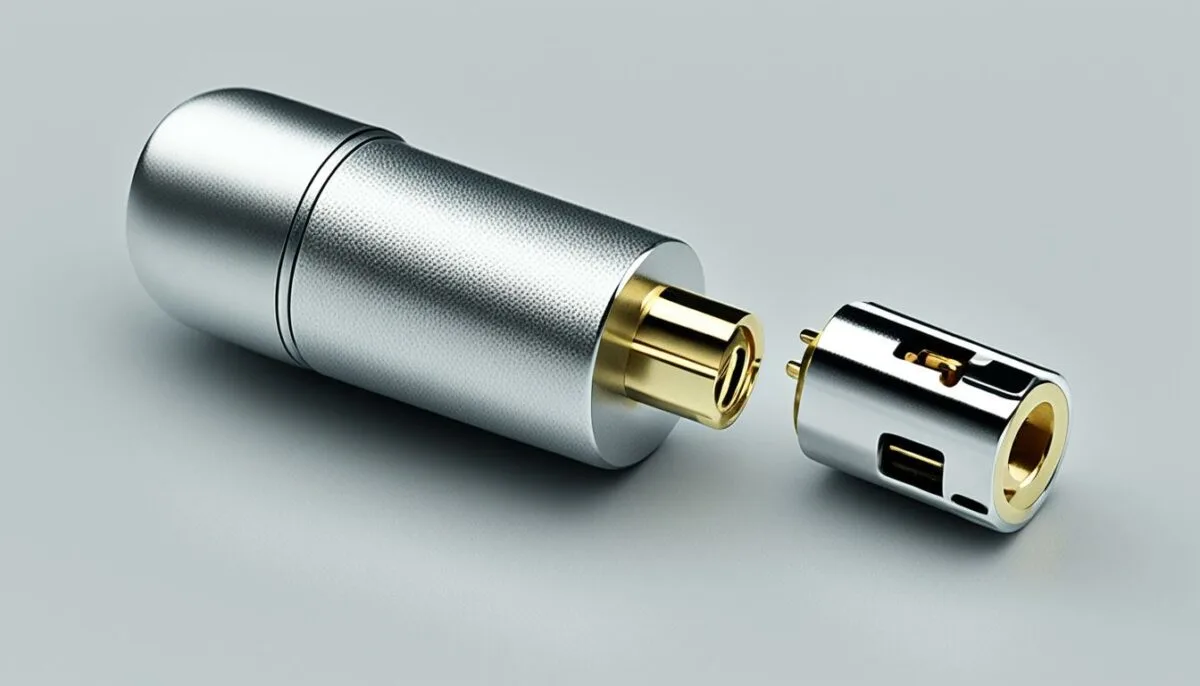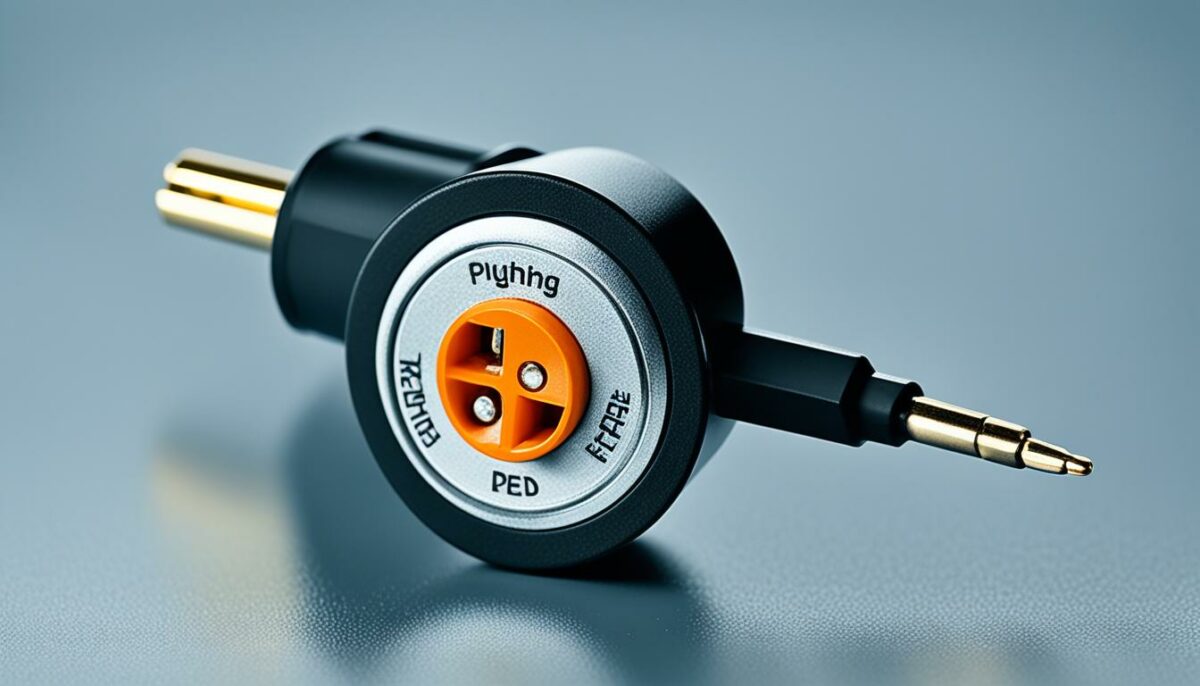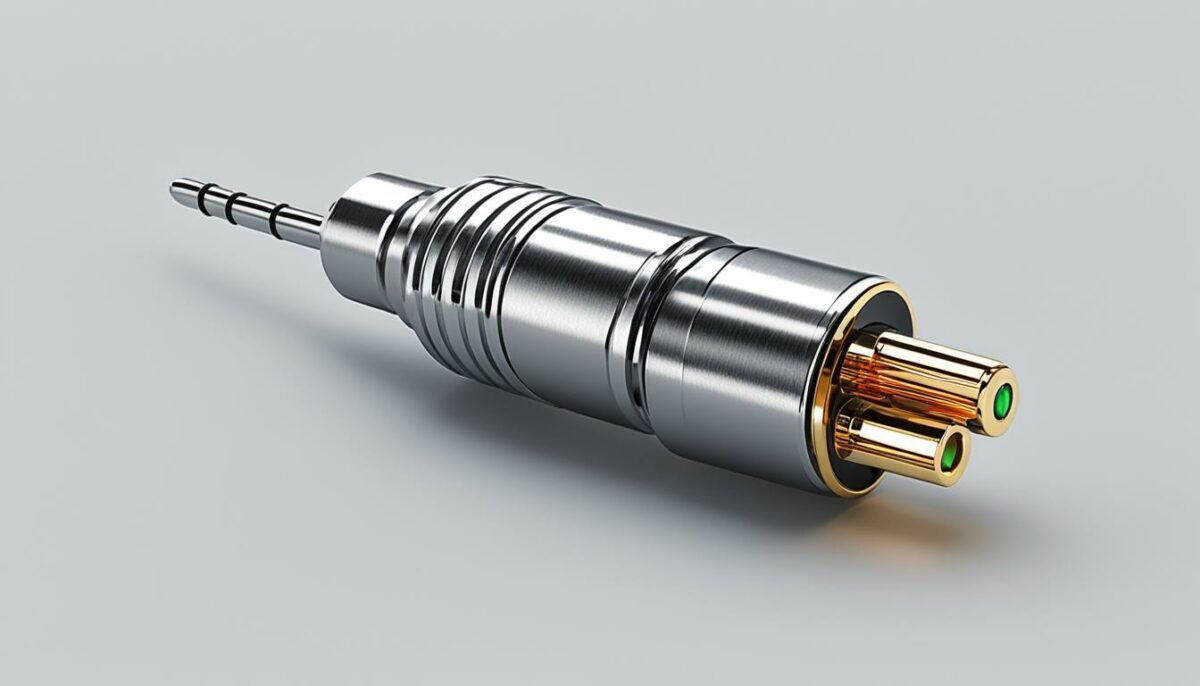Did you know that there are various types of headphone jacks and plugs that determine the quality and compatibility of your audio experience? From the size of the connector to the configuration of the conductors, these small components play a significant role in delivering clear and crisp sound.
When it comes to headphone connectors, it’s important to understand their classifications, functions, and compatibility for a seamless audio experience. In this comprehensive guide, we will explore the anatomy, size, and functionality of different headphone jacks and plugs. We’ll dive into the world of audio jack types, wiring diagrams, and connector sizes, helping you navigate the confusing jargon and avoid common issues that can affect sound quality.
Key Takeaways:
- Headphone jacks and plugs come in various sizes and configurations, which determine their compatibility and functionality.
- The anatomy of a headphone plug includes conductors and insulation bands, which play a crucial role in transmitting audio signals.
- There are different types of headphone plugs, including 2-conductor (TS), 3-conductor (TRS), 4-conductor (TRRS), and 5-conductor (TRRRS) plugs, each with its own specific applications.
- Aside from analog connections, there are also digital connections such as USB and Lightning plugs, which provide direct digital audio signals.
- Choosing the right headphone plug is vital for optimal sound quality, compatibility, and signal transmission.
Anatomy of a Headphone Jack and Plug

A headphone jack and plug consist of two primary components: the jack, which is the port into which you insert your headphones, and the plug, which is the part at the end of the headphone cable that is inserted into the jack. Understanding the anatomy is crucial for identifying the type of connection you’re working with and ensuring compatibility.
The key components to look out for are the conductors and insulation bands. The conductors are the metallic parts of the plug located between the insulation bands, and the number and location of these conductors determine the type of connection. Common conductors include the tip conductor, ring conductor, and sleeve conductor.
“The conductors and insulation bands are like the internal wiring of the headphone plug. They carry the audio signal and ensure proper connection between the headphones and the audio source.”
To better visualize the components, refer to the image below:
Types of Headphone Plugs: 2-Conductor (TS) Plugs

When it comes to headphone plugs, there are various types to choose from, each with its own unique features and applications. One such type is the 2-conductor plug, also known as the TS plug.
The TS plug is primarily used in guitars, instruments, and mono audio applications that do not require a long cable connection. It has two connections: the tip and the sleeve.
The tip carries the audio signal, while the sleeve serves as the ground. This simple design allows for a basic form of audio transmission, making it suitable for mono audio setups.
2-conductor plugs are available in different sizes, including 2.5 mm, 3.5 mm, and 6.35 mm. The choice of size depends on the specific requirements of your equipment and the type of audio connection you need.
If you’re unsure about which size to choose, refer to the specifications of your device or consult with a professional to ensure compatibility.
Overall, 2-conductor plugs are reliable and widely used in various audio applications. They provide a straightforward and efficient means of connecting your headphones or instruments, ensuring a seamless audio experience.
Types of Headphone Plugs: 3-Conductor (TRS) Plugs

When it comes to headphone plugs, one of the most common types you’ll come across is the 3-conductor plug, also known as a TRS plug. These plugs are widely used on stock headphone cables and offer versatile connectivity options for different audio setups.
A TRS plug consists of three connections: the tip, the ring, and the sleeve. Each of these connections plays a crucial role in transmitting audio signals and ensuring a reliable connection between your headphones and audio devices.
The tip is responsible for carrying the audio signal. It’s the conductor that delivers the sound from your device to your headphones, allowing you to enjoy your favorite music, podcasts, or movies. The ring serves as an additional conductor, which can be used for stereo audio signals or for connecting additional audio channels in more complex setups. The sleeve acts as the ground connection, completing the circuit and providing a reference point for the audio signal.
TRS plugs come in various sizes to accommodate different audio equipment. The most common sizes include 2.5 mm, 3.5 mm, and 6.35 mm, catering to a wide range of headphone and audio device compatibility. Additionally, TRS plugs are also available in the form of a 3-pin XLR connector, which is commonly used for balanced mono signals in professional audio setups.
With their support for unbalanced mono, balanced mono, and unbalanced stereo signals, TRS plugs offer flexibility and versatility for various audio applications. Whether you’re connecting your headphones to a smartphone, computer, or audio interface, a TRS plug can deliver reliable audio performance and ensure a seamless listening experience.
“The TRS plug’s tip, ring, and sleeve connections provide a reliable audio connection and versatile compatibility for different audio setups.”
Now that we’ve explored the functionality of TRS plugs, let’s move on to the next section, where we’ll discuss another type of headphone plug: the 4-conductor (TRRS) plug. Its additional connections offer even more audio possibilities.
Types of Headphone Plugs: 4-Conductor (TRRS) Plugs

When it comes to headphone plugs, the 4-conductor (TRRS) plugs are a popular choice. These plugs have four connections: the tip, two rings, and the sleeve. They support unbalanced stereo signals and often include an additional conductor for transmitting microphone audio. The specific configuration of the connections may vary depending on the CTIA or OMTP standards, which dictate the placements of the ground and mic signals.
TRRS plugs are commonly found in sizes such as 2.5 mm and 3.5 mm, making them compatible with a wide range of devices. They were commonly used in older models of smartphones, tablets, gaming consoles, and laptops.
Let’s take a closer look at the different components of a TRRS plug:
- Tip: The tip of the TRRS plug carries the left audio channel.
- First Ring: The first ring carries the right audio channel.
- Second Ring: The second ring is used for transmitting microphone audio.
- Sleeve: The sleeve serves as the ground connection.
TRRS plugs are versatile and can be used with headphones or headsets that have built-in microphones. They provide a convenient solution for both listening to audio and making hands-free calls or recordings.
“TRRS plugs have revolutionized the way we interact with our devices. With a single plug, you can enjoy high-quality audio and easily communicate using the microphone feature.”
Whether you’re using a TRRS plug for personal or professional use, it’s essential to ensure compatibility with your device and audio requirements. Understanding the different types of headphone plugs, such as TRRS plugs, empowers you to make informed choices for an enhanced audio experience.
Types of Headphone Plugs: 5-Conductor (TRRRS) Plugs
When it comes to high-end headphones and maximum audio fidelity, the 5-conductor TRRRS plugs are the epitome of excellence. With five connections – the tip, three rings, and the sleeve – these plugs are designed to deliver balanced stereo audio signals. The TRRRS plugs are commonly available in sizes such as 2.5 mm, 4.4 mm, and even the 4-pin XLR connector, catering to a wide range of audiophile needs. Thanks to their low noise specifications, these plugs ensure an immersive audio experience.
Take a closer look at the anatomy of the TRRRS plug:
| Connection | Description |
|---|---|
| Tip | The tip carries the left audio channel signal. |
| Ring | There are three rings, each dedicated to different audio functionalities. The first ring carries the right audio channel signal, the second ring is for the ground connection, and the third ring is for protective shielding. |
| Sleeve | The sleeve serves as an additional ground connection, ensuring a stable and reliable audio transmission. |
With their balanced stereo capability and superior audio quality, TRRRS plugs are the go-to choice for audiophiles seeking an extraordinary listening experience.
<!–
| Connection | Description |
|---|---|
| Tip | The tip carries the left audio channel signal. |
| Ring | There are three rings, each dedicated to different audio functionalities. The first ring carries the right audio channel signal, the second ring is for the ground connection, and the third ring is for protective shielding. |
| Sleeve | The sleeve serves as an additional ground connection, ensuring a stable and reliable audio transmission. |
–>
Digital Connections: USB and Lightning Plugs
Apart from analog jacks and plugs, there are also digital connections available for headphones: USB and Lightning plugs. These plugs play a crucial role in receiving digital audio signals from devices like phones, laptops, or tablets. To convert these digital signals into analog audio for headphone playback, a digital-to-analog converter (DAC) is located near the plug.
USB plugs are widely used for digital audio connections as they offer a versatile and standardized interface. They are compatible with various devices and can support high-quality audio formats. USB plugs are commonly found on laptops, desktop computers, and audio interfaces. They allow for direct digital connections, eliminating the need for additional analog conversions.
Lightning plugs, on the other hand, are specific to Apple devices such as iPhones and iPads. They provide a direct digital audio connection and offer high-resolution audio playback. Lightning plugs also have the advantage of delivering power to the connected headphones or other devices, ensuring uninterrupted audio playback and charging simultaneously.
USB and Lightning plugs are commonly used for headphones that require a direct digital connection for optimal sound quality. Their ability to transmit digital audio signals ensures a clean and accurate audio reproduction, avoiding any potential degradation that may occur through analog conversions.
With the rising popularity of digital music streaming and high-resolution audio formats, USB and Lightning plugs have become essential for audiophiles and music enthusiasts who seek uncompromising sound quality. These digital connections provide a convenient and efficient way to enjoy music in its purest form.
Now, let’s take a look at a comparison table highlighting the key features of USB and Lightning plugs:
| Plugs | Compatibility | Audio Quality | Power Delivery | Usage |
|---|---|---|---|---|
| USB Plugs | Compatible with various devices (laptops, desktops, audio interfaces) | Supports high-quality audio formats | Depends on the device and USB version | Widely used in professional audio setups, home listening, and gaming |
| Lightning Plugs | Specific to Apple devices (iPhones, iPads) | Offers high-resolution audio playback | Delivers power to connected devices | Popular among Apple users for music listening and media consumption |
Common Issues with Headphone Jacks and Plugs
While headphone jacks and plugs are designed to provide a seamless audio experience, they can sometimes encounter issues that affect sound quality. Let’s take a closer look at some of the common problems users may face:
1. Broken headphone jack clamping mechanism
One common issue is a broken clamping mechanism in the headphone jack. This can result in a loose connection between the plug and the jack, leading to static interference in the audio. When the clamping mechanism is compromised, the plug may not fit securely into the jack, causing intermittent sound or even complete loss of audio.
2. Dirt in the headphone jack and plug
Another issue that can affect sound quality is the accumulation of dirt, dust, or debris in the headphone jack and plug. Over time, these particles can build up and interfere with the electrical connection, resulting in muffled or distorted audio. Regular cleaning of the jack and plug can help prevent this problem and maintain optimal sound quality.
3. Physical damage to the plug
Physical damage to the headphone plug can also lead to issues with sound quality. When a plug gets bent, crushed, or otherwise damaged, it may not align properly with the jack, causing poor contact with the conductors. This can result in audio dropouts, static, or overall reduced sound quality. Taking care of your headphones and avoiding rough handling can help prevent physical damage to the plug.
By being aware of these common issues and taking proper care of your headphone jacks and plugs, you can ensure a better audio experience and avoid unnecessary disruptions in sound quality.
Importance of Choosing the Right Headphone Plug
Choosing the right headphone plug is crucial for ensuring compatibility, achieving optimal sound quality, and maintaining signal transmission quality. Using the wrong plug can result in distorted or muted audio, reduced durability, and overall poor performance.
When selecting a headphone plug, it’s important to consider the specific requirements of your audio setup. Different devices and headphones may have varying plug configurations and sizes, so understanding compatibility is essential. A plug that fits properly and securely into the headphone jack ensures a stable connection and reliable audio output.
Sound quality is another critical factor to consider. The quality of the plug, including the materials used and the construction, can affect the overall sound performance. A well-made plug can minimize signal loss and interference, delivering clear and accurate audio reproduction.
Additionally, plug quality plays a role in durability and longevity. A sturdy and well-designed plug is less likely to break or wear out over time, ensuring a longer lifespan for your headphones. Investing in a high-quality plug can save you from the hassle and expense of frequent replacements.
Furthermore, the chosen headphone plug directly impacts signal transmission. A reliable plug with good conductivity helps maintain the integrity of the audio signal, preventing any degradation during transmission. This translates to a cleaner and more faithful sound reproduction.
Ultimately, making an informed choice when selecting a headphone plug can greatly enhance your audio experience. Consider the unique characteristics of your devices, prioritize sound quality and plug durability, and ensure compatibility for optimal performance. By choosing the right headphone plug, you’ll enjoy crystal-clear sound and a hassle-free audio connection.
Conclusion
Understanding headphone jacks and plugs is essential for achieving the best audio experience. By familiarizing yourself with the different types of connectors, audio jack types, and headphone plug sizes, you can make informed decisions and ensure compatibility with your devices.
Whether you’re dealing with TS, TRS, TRRS, or TRRRS plugs, it’s important to consider factors like conductor configuration, size, and usage. This knowledge will help you select the right plug for your specific needs and optimize sound quality.
Remember, the headphone wiring diagram and understanding the anatomy of headphone jacks and plugs play a crucial role in ensuring a seamless connection. By paying attention to these details, you can enjoy a superior audio experience without any issues.
So, next time you’re shopping for headphones or dealing with connectors, keep these insights in mind. Armed with this knowledge, you can confidently choose the correct headphone plug and take your audio enjoyment to the next level.